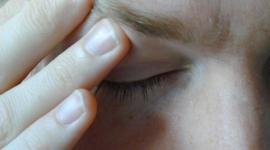Pain and Your Child or Teen

Comprehensive information on pain in children, the causes of pain, and treatment of chronic pain in children.
One in fifty children and adolescents live with severely debilitating and recurrent pain. As many as 15 percent of children suffer from headaches, abdominal and musculoskeletal pain but two percent of children have pain symptoms that can be severe enough to interrupt sleep, restrict physical activity and prevent them from attending school.
Studies have shown that children suffering from this kind of chronic pain frequently become emotionally distressed and have a heightened sense of vulnerability, which can have a major impact on parents and siblings.
What Is Pain?
Pain is an uncomfortable sensation or feeling. It is such an important factor in health that it has been called the "fifth vital sign [1]." It can be constant (always there) or intermittent (coming and going). Pain can be dull and aching, sharp, or throbbing. It can be both physical and mental, and every child experiences it differently. It is important to know that no one can describe what your child's pain feels like except your child. Pain may be just a nuisance, or it may interfere with your child being able to get through their normal daily activities.
What Causes Pain?
We feel pain when our brain sends out special signals to our bodies. Usually, we are sick or injured when our brains send these signals. Feeling pain usually serves a purpose—it is a signal that something is wrong.
What Is the Difference Between Chronic and Acute Pain?
Pain can be acute (lasting for a short time) or chronic (lasting for a much longer time, perhaps months or years). Chronic pain often goes misdiagnosed. Unlike acute pain, it serves no useful purpose, but rather causes needless suffering if it goes untreated. Untreated or under-treated chronic pain can disrupt the family routine, and interfere with your child's daily activities, which can, in turn, lead to long-term disability. The key to treating chronic pain is doing a good job of recognizing and describing it frequently along the way to ensure that treatment is working as it should [2].
How Can I Recognize Pain in My Child? Why Is Describing Pain So Important?
Everyone can feel pain, even babies and young children. Kids usually do not remember the pain they went through when they were younger than about two years old. Sometimes children have a hard time expressing themselves and may find it hard to tell you where it hurts and what it feels like.
For this reason, doctors and nurses are using new tools to help define pain in the kids they care for. Pain charts and scales for children use pictures or numbers to describe their pain. Describing the pain can help parents and health care providers understand how bad the pain is, and how to best treat it. Talking to your child's doctors and nurses about pain is important. The more they know about your child's pain, the more they can help. Pay attention to how your child acts. For example, when your child is in pain, they may be restless or unable to sleep.
Pain can be treated. It can go away! The first step in treating your child's pain is to tell your child's doctor or nurse about it. Your health care provider will ask several questions about the pain, including where it hurts, what it feels like, and how it has changed since it started.
Your child's doctor may ask you to keep a pain diary with your child, which keeps track of when your child has pain throughout the day. This diary can also document how the pain changes after taking pain medications. If medications do not seem to work, or if your child has a bad reaction, tell the doctor and keep a list of these problem medicines for future reference.
Why Is Treating Pain Important?
Kids in pain do not do as well as kids who keep their pain under control. Pain can slow down your child's recovery. Also, pain is easier to treat before it gets really bad. So it's a good idea for your child to keep close tabs on how they feel, so pain can be "nipped in the bud." If we treat pain right away—before it gets out of control—we find that we actually need less medication overall to get it and keep it under control.
How do I know if I should call the doctor?
Remember: pain is a sign that something is wrong. Call your child's doctor if your child is in severe pain or has pain that lasts more than one or two days. If your child is in the hospital, let your nurse or doctor know right away if your child has pain.
What About Pain Medication?
Most pain can be controlled with medications. It is a good idea to combine treatment with medicine with some of the non-drug pain-control treatments listed farther down this page [3]. There are many different kinds of medications that your doctor may want to try to help relieve your child's pain and discomfort.
Will my child become addicted to pain medication?
If your child is being treated long term pain, you may worry about them becoming addicted to pain medicine. Don't worry: addiction is very rare. If your child needs pain medications and sedatives for a long time, physical dependence may occur. Physical dependence is not the same as addiction—addiction is a psychological problem. Because of this physical dependence, medication doses will be decreased slowly to prevent possible withdrawal symptoms that can occur if the medicine is stopped suddenly. Nurses and doctors will watch your child carefully for signs of medication withdrawal. Comfort measures as discussed below can be helpful when doses of pain medications are being decreased.
Are there other ways to treat pain besides taking medicine?
Absolutely! Pain is best treated using a variety of non-drug treatments along with medication [3].
One of the most important measures to take is to be there for your child. If your child feels loved and supported, their pain won't hurt as much. Cuddle, hold, rock, and hug your child. Hold your child's hand, and let them know you love them. Calm your child, because anxiety makes the pain worse. If your child has learned some of the techniques for coping with pain, they may still need you or a nurse to coach them and remind them what and how to use these techniques. For example, you may need to guide your child in using relaxation techniques, even if your child is already familiar with how to do it [4].
Other examples of non-drug treatments include therapy, massage, hot or cold packs, relaxation and guided imagery, distraction, music, hypnotherapy, and reading to your child. It's a good idea to use many of these techniques together in ways that complement each other. For example, researchers found that using acupuncture and hypnotherapy together was effective at reducing chronic pain and well tolerated by young people in their study [5]. The experts who can help your child cope with and treat pain may include massage therapists, biofeedback technicians, physician-acupuncturists, child-life specialists, psychologists, and physical or occupational therapists.
Literature Cited:
[1] Lynch M. Pain: the fifth vital sign. Comprehensive assessment leads to proper treatment. Adv Nurse Pract. 2001 Nov;9(11):28-36.
[2] Chambliss CR, Heggen J, Copelan DN, Pettignano R. The assessment and management of chronic pain in children. Paediatr Drugs. 2002;4(11):737-46.
[3] Rusy LM, Weisman SJ. Complementary therapies for acute pediatric pain management. Pediatr Clin North Am. 47(2000):589-99.
[4] Cohen LL, Bernard RS, Greco LA, McClellan CB. A child-focused intervention for coping with procedural pain: are parent and nurse coaches necessary? J Pediatr Psychol. 2002 Dec;27(8):749-57.
[5] Zeltzer LK, Tsao JC, Stelling C, Powers M, Levy S, Waterhouse M. A phase I study on the feasibility and acceptability of an acupuncture/hypnosis intervention for chronic pediatric pain. J Pain Symptom Manage. 24(2002):437-46.
[6] Kemper KJ, Sarah R, Silver-Highfield E, Xiarhos E, Barnes L, Berde C. On pins and needles? Pediatric pain patients' experience with acupuncture. Pediatrics. 2000 Apr;105(4 Pt 2):941-7.
[7] Favara-Scacco C. Smirne G. Schiliro G. Di Cataldo A. Art therapy as support for children with leukemia during painful procedures. Medical & Pediatric Oncology. 36(4):474-80, 2001 April.
See Also:
Sources:
- University of Bath, UK
- University of Michigan Health System
APA Reference
Staff, H.
(2022, January 17). Pain and Your Child or Teen, HealthyPlace. Retrieved
on 2025, December 7 from https://www.healthyplace.com/parenting/chronic-pain/pain-and-your-child-or-teen


